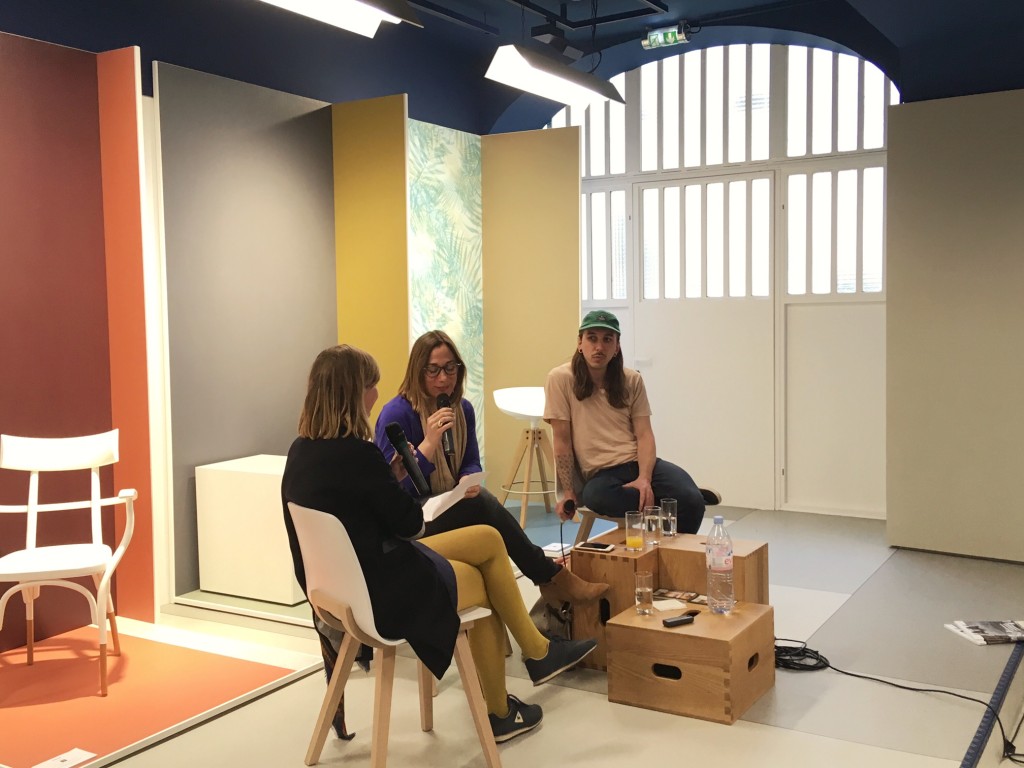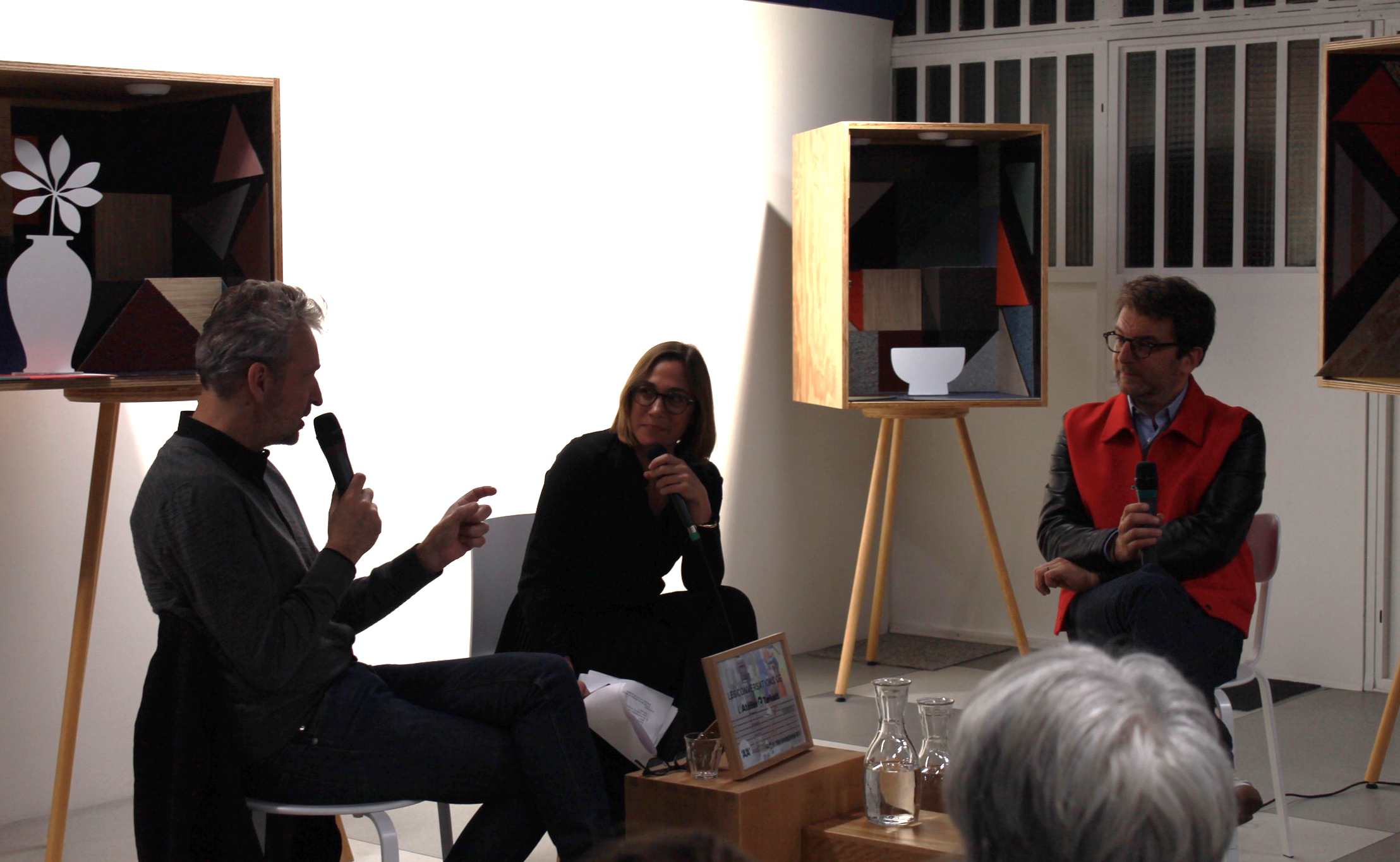Creative Affinities #2, a conversation between Ann Guillaume and Guillaume Aubry
On 24 April, Atelier Tarkett hosted a second conversation organised by AA as part of the “Creative affinities” series. It was a meeting between artist Ann Guillaume and architect Guillaume Aubry, co-founder of Freaks Architecture with Cyril Gauthier and Yves Pasquet in 2007. Discover the selected excerpts of this conversation, published in our latest issue.

Emmanuelle Borne: For the second conversation of our “Creative affinities” series, whose aim is to bring architects and artists together to discuss the creative act, we invited two people who already know each other well: an architect with one foot in the art world and an artist whose art borrows from archaeology. Guillaume Aubry, you and your fellow architects from Freaks chose to engage in art at the same time as you did in architecture. Why?
Guillaume Aubry: From the start, we have all been interested in art, visual arts, exhibition and production sites, as well as places to store works. Even though nothing is due to chance, we began working on the renovation of a very small associative art gallery, called Glassbox, in Paris 11th arrondissement, and then we worked on the scenographic design of an exhibition for the Ministry of Culture at the 2010 Heritage Fair. It was only then that we put together bids to take part in public call for tenders. In 2012, we saw the competition for a maison de l’économie créative (Méca – Creative Economy Centre) bringing together three cultural players, including the Frac Aquitaine. We asked Bjarke Ingels, who we didn’t know back then, to join us. We won the competition together and today, the work is nearly complete. In the end it gave us direction and we now focus mainly on cultural projects.
EB: What remains of your artistic approach?
GA: We continue it. For example, taking a few photos of our work is not satisfactory. We are interested in the way in which an architecture project is documented. Photo reports are often nothing more than a composition including a Le Corbusier chair, an orchid on an occasional table and the poster of a Gursky. So we felt that we could probably do something more and very quickly we began to work with photographers on how to script a photo session. For the completion of our very first raised building in Saint-Ouen, we dressed up as thieves to play out a burglary, because who better to burgle houses than the architects who designed them? This is how we ended up filming and performing.
EB: Ann Guillaume, you are quite familiar with the Freaks approach. In what way has it influenced you and what does being a “mediation artist” involve?
Ann Guillaume: I consider myself a mediation artist because I work to create bridges between disciplines. My art is for anthropologists, archaeologists, artists, architects, shepherds, water diviners, foresters, etc. When I refer to an art of mediation, it is because, through formal experiments and surveys, I try to inspire the idea that artists can address governing bodies and stand up for people who are poorly represented, or entities or people from distant places. In short, the artist is not alone. His place is in the city. What’s more, like Freaks, I have pursued an approach that takes the site, the place and all the people that create the ecosystem of the environment into account. Besides, when Guillaume refers to documentation, one thing that I found fascinating in the Freaks’ approach is that the documents produced to create a working environment can be an inherent part of the work. My art projects focus on the telling of the story.
EB: Both of you certainly take more of an interest in the creative process than the final result or the finishing touches. Why is this?
AG: As I often respond to a commission that is expressed in terms of a specific problem, I get to carry out field surveys. The part I like most is collaborating with all the players or entities involved. For me, the ultimate goal is not the exhibition, but co-production. Artists are not magicians any more than architects. Things take time to emerge: why not show this process as a part of the work? In any case, there is always a form of rendition at a given time, renditions that I call “getting to work”.
GA: We believe that you do not determine a good project by its choice of colour, materials or lighting devices. Without being in any way condescending, we really try to develop a rationale that explains architecture. In other words circulation, organisation of volumes, programming, etc. We are probably tempted to let go of a project a little faster than some architects, when we get down to details. Remember how the Haussmannian bourgeois apartments were built with an architect, but also an interior architect, who was responsible for the ceiling and the design of the handles. These days, the architect willingly retrieves a section of the execution details, but we prefer to leave that to the experts!
EB: Ann Guillaume, traditionally the artist avoids commissions, but you go looking for them. Why is this?
AG: In 2016, I took part in the SPEAP (Ed. Master’s degree in Experimentation in Political Art), created by Bruno Latour at Sciences Po. There were 15 of us, of all ages, all very hybrid: architects and poets, biologists and urban planners, socially involved exhibition curators – and myself, artist, researcher and anthropologist. The interesting thing about this training was that we suggested bidding for commissions and this is where I learnt that I could envisage new methodologies for working together on situated knowledge. I chose a commission from the Ministry of Culture, which involved helping them outline the pre-project resulting from an important cultural policy: the construction of a Villa Medici in Clichy Montfermeil. This project dated back to the time when Frédéric Mitterrand was the Minister of Culture. “Art can save the world,” he said. As naive as it seems, this sentence is fantastic. It is much more complicated than it seems! So I worked on this subject. We carried out a survey of everything… except the Villa Medici itself. We employed a two-tier strategy which enabled us to explore improbable avenues of reflection. We went out into the underground spaces of the city, the gaps that the Grand Paris Metropolis would make until 2022. Our question was the following: if we dig, what do we find? Couldn’t the Villa Medici in Clichy Montfermeil emerge from below ground, rather than being parachuted in from the sky? Can this land be used for something new and how? It was fascinating.
EB: At Freaks, you work on public and private commissions, but also commissions that you invent. Why invent an additional commission?
GA: As an architect, it is frustrating to always have to answer the question you are asked. We produced the film Modulor in one of the apartments of the Cité Radieuse in Marseille. We felt like questioning this heritage. We worked with two professional actors, a tall man and a small one, on daily activities such as washing one’s teeth, going up and down stairs, sitting in alcoves and so on. We filmed at eye level for each of them, which gives different perceptions of space. It was a way of undermining this standardised architecture. We also invented this commission to communicate, because we do not consider communication to be a bad thing. We do it with our tools, our resources and the way we want to. .
Armelle Poungui.
For more infirmations about Atelier Tarkett, click here.


